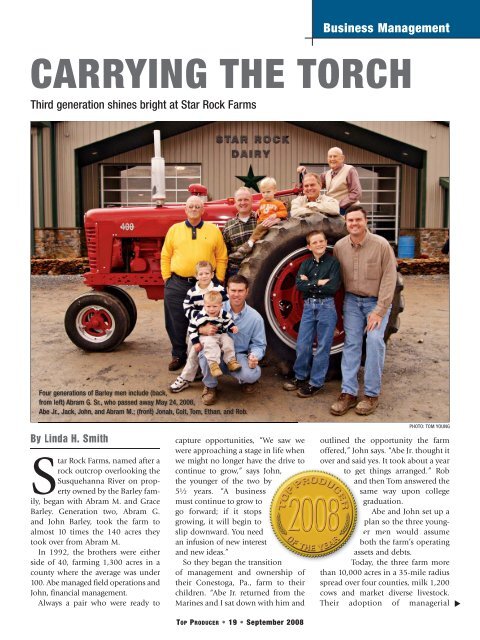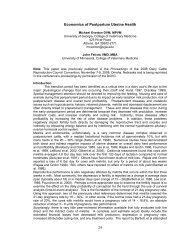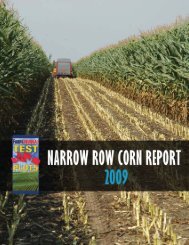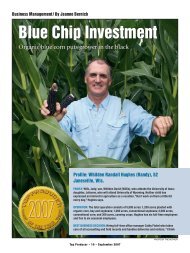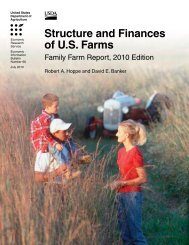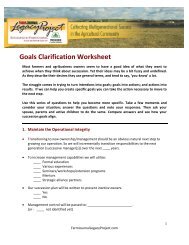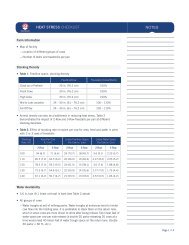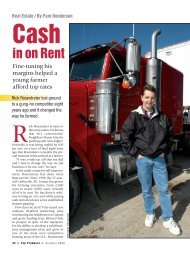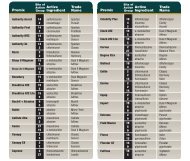Star Rock Farms - AgWeb
Star Rock Farms - AgWeb
Star Rock Farms - AgWeb
You also want an ePaper? Increase the reach of your titles
YUMPU automatically turns print PDFs into web optimized ePapers that Google loves.
Business Management<br />
CARRYING THE TORCH<br />
Third generation shines bright at <strong>Star</strong> <strong>Rock</strong> <strong>Farms</strong><br />
Four generations of Barley men include (back,<br />
from left) Abram G. Sr., who passed away May 24, 2008,<br />
Abe Jr., Jack, John, and Abram M.; (front) Jonah, Colt, Tom, Ethan, and Rob.<br />
By Linda H. Smith<br />
<strong>Star</strong> <strong>Rock</strong> <strong>Farms</strong>, named after a<br />
rock outcrop overlooking the<br />
Susquehanna River on property<br />
owned by the Barley family,<br />
began with Abram M. and Grace<br />
Barley. Generation two, Abram G.<br />
and John Barley, took the farm to<br />
almost 10 times the 140 acres they<br />
took over from Abram M.<br />
In 1992, the brothers were either<br />
side of 40, farming 1,300 acres in a<br />
county where the average was under<br />
100. Abe managed field operations and<br />
John, financial management.<br />
Always a pair who were ready to<br />
capture opportunities, “We saw we<br />
were approaching a stage in life when<br />
we might no longer have the drive to<br />
continue to grow,” says John,<br />
the younger of the two by<br />
5½ years. “A business<br />
must continue to grow to<br />
go forward; if it stops<br />
growing, it will begin to<br />
slip downward. You need<br />
an infusion of new interest t<br />
and new ideas.”<br />
So they began the transition<br />
of management and ownership of<br />
their Conestoga, Pa., farm to their<br />
children. “Abe Jr. returned from the<br />
Marines and I sat down with him and<br />
TOP PRODUCER • 19 • September 2008<br />
PHOTO: TOM YOUNG<br />
outlined the opportunity the farm<br />
offered,” John says. “Abe Jr. thought it<br />
over and said yes. It took about a year<br />
to get things arranged.” Rob<br />
and then Tom answered the<br />
same way upon college<br />
graduation.<br />
Abe and John set up a<br />
plan so the three young-<br />
er men would assume<br />
both the farm’s operating<br />
assets and debts.<br />
Today, the three<br />
farm more<br />
than 10,000 acres in a 35-mile radius<br />
spread over four counties, milk 1,200<br />
cows and market diverse livestock.<br />
Their adoption of managerial<br />
▼
accounting, strong financial performance<br />
and growth in an area riddled<br />
with suburban sprawl earned them<br />
one of the three 2008 Top Producer<br />
of the Year awards.<br />
Transitional challenge. Although<br />
by no means unheard of in agriculture,<br />
among family businesses the<br />
Barley operation is among an elite<br />
group. Only 30% make<br />
the transition from first to<br />
second generation, and<br />
just 12% to third generation.<br />
By the fourth generation,<br />
a measly 3% are still<br />
in existence.<br />
Common causes of failure<br />
are inadequate estate<br />
planning, insufficient capitalization<br />
and failure to prepare the<br />
next generation, says Kevin Stafford<br />
of Legacy by Design in Chico, Calif.<br />
“The Barley family has done an<br />
exceptionally good job,” says Jan<br />
Graybill of Legacy Planning Partners<br />
in Coopersburg, Pa. “Books about<br />
entrepreneurs agree that after 25 years<br />
in a business, they become entrenched<br />
in their thinking. It is time for the<br />
next generation to infuse its energy<br />
into the business.<br />
“John and Abe recognized that,” he<br />
says. “They began at an earlier age<br />
than many owners do, and they were<br />
willing to turn over responsibility to<br />
the younger generation—something<br />
Managerial<br />
accounting<br />
validates<br />
decisions<br />
often resisted by business founders.”<br />
“That’s where so many transitions<br />
fail,” John says. “The older generation<br />
wants to continue to run the business—I’ve<br />
seen some who wanted to<br />
rule from the grave. You have to be<br />
there as an advisor, not a dictator.<br />
Talk it out. Communication is critical<br />
if you are going to be in a family<br />
business, John adds. “The<br />
elder generation should<br />
praise generously and not<br />
be critical of mistakes, which<br />
provide a chance to learn.”<br />
Communication also is<br />
key for the next generation,<br />
the partners say. “In<br />
general, our different personalities<br />
complement<br />
each other, but if we have differences,<br />
we talk about them,” Abe says. “When<br />
we disagree, we don’t challenge the<br />
person. We challenge the idea or practice<br />
to make sure it is the right decision.”<br />
Such discussions help uncover<br />
better decisions and ways to do things,<br />
Tom adds.<br />
Divvying up responsibilities helps<br />
them avoid stepping on each others’<br />
toes. Walking in his father’s footsteps,<br />
Rob runs the office and livestock;<br />
Tom’s arena is the dairy and Abe<br />
takes to the field. “Specializing helps<br />
avoid scattered attention,” Tom says.<br />
“For example, I can worry about the<br />
cows—not paying bills.”<br />
▼<br />
<strong>Star</strong> <strong>Rock</strong> <strong>Farms</strong>’<br />
Mission Statement<br />
To produce Quality Agriculture<br />
Products in an<br />
efficient, well-managed<br />
and progressive operation.<br />
Accomplishing this<br />
while maintaining a safe,<br />
friendly working environment<br />
for employees.<br />
Seeking to develop and<br />
maintain open and honest<br />
relationships with<br />
employees, vendors, professionals<br />
and neighbors.<br />
PHOTO: DANA TIMMINS<br />
TOP PRODUCER • 20 • September 2008
Accounting boost. One of the first<br />
steps generation three took was to<br />
ratchet up their accounting a notch.<br />
Pennsylvania Farm Bureau’s Farm<br />
Business Farm Management service<br />
had served brothers John and Abe<br />
well, but the current generation<br />
adopted enterprise accounting.<br />
“While tractor-seat management<br />
worked for previous generations, today’s<br />
economics require the use of<br />
enterprise and cost accounting to<br />
validate management decisions and<br />
<strong>Star</strong> <strong>Rock</strong> <strong>Farms</strong>, Conestoga, PA<br />
support bank credit requests,” says<br />
Lowell Fry, vice president of Fulton<br />
Bank in Lancaster, Pa.<br />
“Combined records didn’t allow us<br />
to analyze strengths and weaknesses<br />
in each of our major activities,” Rob<br />
explains. “Profitable areas could easily<br />
mask losing activities.”<br />
So the Barleys hired an accounting<br />
firm and, within the past five years,<br />
have adopted an aggressive system of<br />
managerial accounting to determine<br />
the profitability of each enterprise<br />
PROFILE OF THE OPERATION: <strong>Star</strong> <strong>Rock</strong> <strong>Farms</strong>, <strong>Star</strong> <strong>Rock</strong> Dairy, <strong>Star</strong> <strong>Rock</strong><br />
Services and Barley <strong>Farms</strong>, owned and managed by Abe Jr. (42), Rob (39) and Tom<br />
(37) Barley, Conestoga, Pa. Diversified crop and livestock farm that has grown<br />
rapidly in an area where suburban sprawl is replacing farmland. Managerial<br />
accounting and a sharp eye on financial ratios help them meet profit goals.<br />
and where best to invest capital.<br />
Knowing their cost of production<br />
helps them decide what to pay for<br />
rents—and what farms they may not<br />
want to keep, Rob says.<br />
Now the partners are studying<br />
quarterly reports for each business<br />
unit to catch financial trends early<br />
and take remedial action if needed,<br />
Rob says. “Also, we can now compare<br />
our business units with industry data<br />
to evaluate our performance.”<br />
As their banker, Fry adds: “Loans<br />
can be supported by numbers and<br />
tracked for performance. Furthermore,<br />
management can mitigate market risk<br />
and cash flow volatility through contractual<br />
relationships based on accurate<br />
costs of production. By lowering<br />
business risk, the bank’s risk is reduced<br />
and the Barleys have access to<br />
more, less costly, credit.”<br />
PHOTOS: DANA TIMMINS<br />
ABE: Being a sergeant in the Marine Corps<br />
provided leadership training and management—<br />
he led people.<br />
ROLE AT THE FARM: Manages farm operations.<br />
FAMILY: Wife, Jen, is a physical therapist;<br />
Abby (14), Ellie (10) and Jack (5) are involved<br />
in sports.<br />
OTHER INTERESTS: Weightlifting, bicycling,<br />
hunting, Honor Guard at military funerals, antique<br />
tractor pulls.<br />
ROB: Studied animal science with a business<br />
emphasis, Penn State University.<br />
ROLE AT THE FARM: Overall financial management;<br />
livestock operations other than dairy.<br />
FAMILY: Wife, Shelly, is church secretary;<br />
Michaela (9), Laurel (5), Ethan (12) and Amelia<br />
(16) are involved in sports and show dairy cows<br />
and hogs.<br />
OTHER INTERESTS: Leads church youth group.<br />
TOM: Business management, Millersville<br />
University.<br />
ROLE AT THE FARM: Dairy operation.<br />
FAMILY: Wife, Elizabeth, is a preschool teacher;<br />
Emma (11), Jonah (9), Ivy (7) and Colt (5) are<br />
involved in sports and 4-H dairy cattle showing.<br />
OTHER INTERESTS: Bicycling, dairy cow showing.<br />
TOP PRODUCER • 22 • September 2008<br />
Four entities. At the same time the<br />
Barleys switched accounting practices,<br />
they carved their business into<br />
four entities to allow them to better<br />
identify the strengths and weaknesses<br />
in each of their major activities.<br />
Each enterprise—and any new investment—has<br />
to pass two tests: Will it<br />
stand on its own and will it enhance<br />
the overall operation<br />
• <strong>Star</strong> <strong>Rock</strong> <strong>Farms</strong> initially included<br />
2,000 beef cattle, 7,000 hogs,<br />
100,000 broilers and 130,000 laying<br />
hens. Based on the Barleys’<br />
financial records, they have converted<br />
ownership of the cattle to a<br />
3,800-head custom feeding operation<br />
and gotten out of the layers.<br />
• <strong>Star</strong> <strong>Rock</strong> Dairy started with 400<br />
cows. In 2004, the family built a<br />
state-of-the-art facility and expanded<br />
to a milking herd of 1,100.<br />
• <strong>Star</strong> <strong>Rock</strong> Services grew from 6,000<br />
acres of corn, soybeans, wheat, barley<br />
and hay to over 10,000 acres.<br />
• Barley <strong>Farms</strong> became a real estate<br />
partnership to manage the family’s<br />
properties and rental ground.<br />
Reputation. Their growth has been<br />
fueled by word of mouth, the partners<br />
say, bringing land rentals their<br />
way. “We just try to do a good job<br />
and build relationships,” Rob says.<br />
▼
“I give the guys credit for developing<br />
the business plan and growing as<br />
they have,” John says. “They have<br />
leveraged opportunities in ways I<br />
probably never would have<br />
dreamed of. ”<br />
Internal growth. At <strong>Star</strong><br />
<strong>Rock</strong> today, the cousins<br />
aren’t averse to growth<br />
when opportunities arise,<br />
but for the next two to five<br />
years, their main focus is to<br />
be as efficient as possible<br />
and to reduce debt.<br />
“We would consider an enterprise<br />
that would enhance current operations,”<br />
Rob says. “But it would have<br />
to have a compelling story.”<br />
Thinking outside the box to afford<br />
land, they are willing to sell development<br />
rights in an area where preservationists<br />
are active; sell timber; or<br />
enter a sale-leaseback arrangement,<br />
as they did with one property where<br />
an existing business wants to expand.<br />
Growth has<br />
been fueled<br />
by word<br />
of mouth<br />
They have begun planning for the<br />
next generation’s transition.<br />
“Each generation of the Barley family<br />
has proven an ability to adjust to<br />
and adopt emerging<br />
trends,” says banker Fry.<br />
“As agriculture now<br />
demands that business<br />
practices change, the<br />
Barleys have led the way<br />
by adopting financial practices<br />
that will lead to<br />
informed decisions, positioning<br />
the business for<br />
continued profitability and succession<br />
to the next generation.” ■<br />
To contact Linda H. Smith, e-mail<br />
LSmith@farmjournal.com.<br />
FOR AN APPLICATION or<br />
to read about previous winners,<br />
visit www.ToProducer.com and<br />
scroll down to Special Features.<br />
Deadline is Sept. 30, 2008!<br />
Steps to a Successful Succession<br />
In a perfect world, your succession plan actually begins when your children are<br />
in preschool. You groom them as business managers by giving them responsibilities,<br />
praising them when they do well and letting them learn from mistakes.<br />
However, the more explicit succession plan, with its business and legal aspects,<br />
often kicks off somewhat later. Jan Graybill, a managing partner of Legacy<br />
Planning Partners, in Coopersburg, Pa., who works with the Barley family, names<br />
three steps or phases.<br />
Phase 1: Contingency plan. This is simply a basic plan for how to keep the<br />
farm in operation in case of a catastrophe such as the death, disability or voluntary<br />
withdrawal of an owner. “It’s similar to backing up your computer regularly,”<br />
says Graybill. You make certain you have sufficient liquidity and a manager who<br />
can take over. This phase may include estate planning, life insurance and the like.<br />
Phase 2: Succession plan. This defines the current owner’s plan to shift<br />
management and ownership to the next generation. “On the financial side, you<br />
need to make sure there is sufficient income to fund your retirement but not place<br />
too heavy a burden on the younger generation,” Graybill adds. “On the management<br />
side, you have to allow the next generation to begin calling the shots while<br />
you are alive so they can gain from your experience.” Ownership and management<br />
do not necessarily involve the same people, he notes.<br />
Phase 3: Next generation estate planning. Right from the start, the next<br />
generation should form its business structure and investments with its successors<br />
in mind. Then, the plan should be reviewed and adjusted every five years.<br />
“It’s easy for young managers to focus on the day-to-day business and never<br />
get a plan in place,” Graybill says. “It’s really important in your 20s, 30s and 40s<br />
to talk about what you want in your 50s, 60s and beyond. Setting goals allows you<br />
to arrange things so the money will be there and you will have more options.”<br />
TOP PRODUCER • 24 • September 2008


